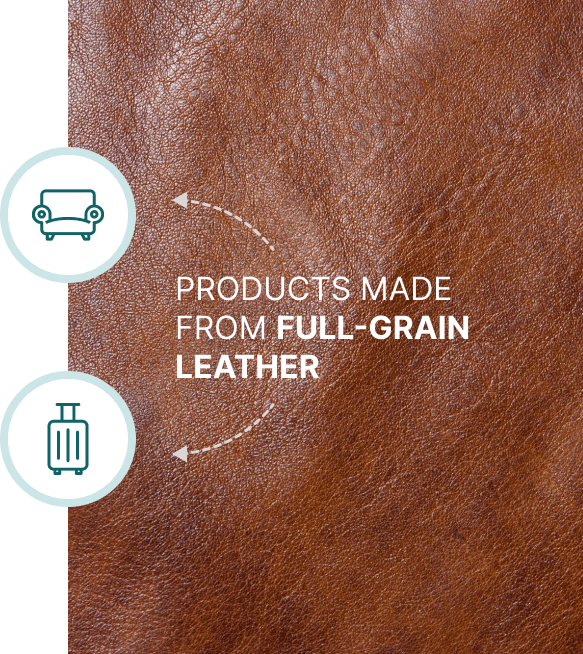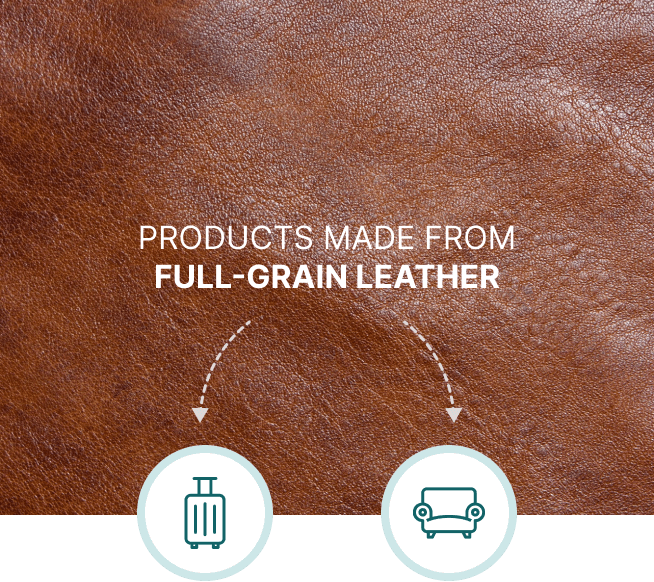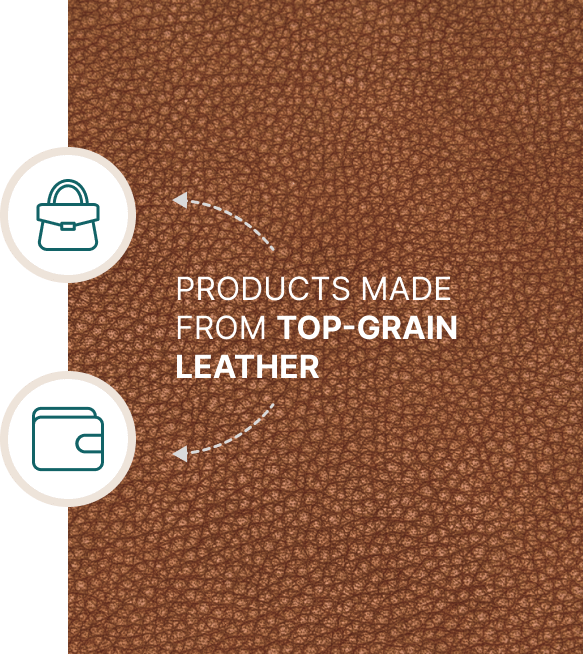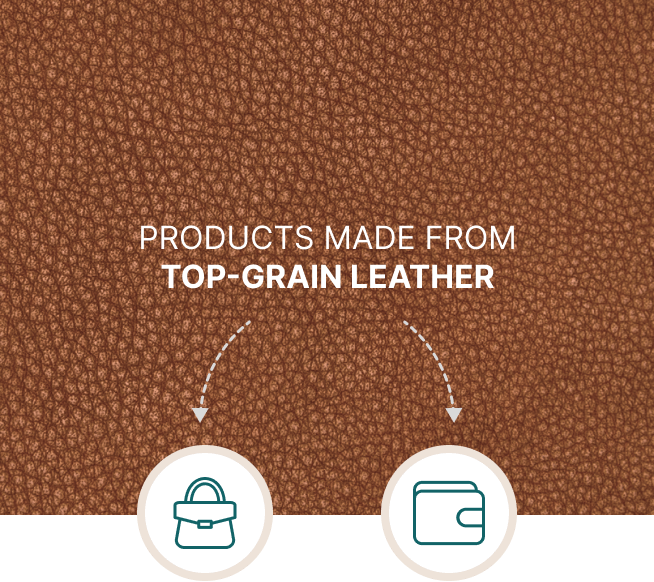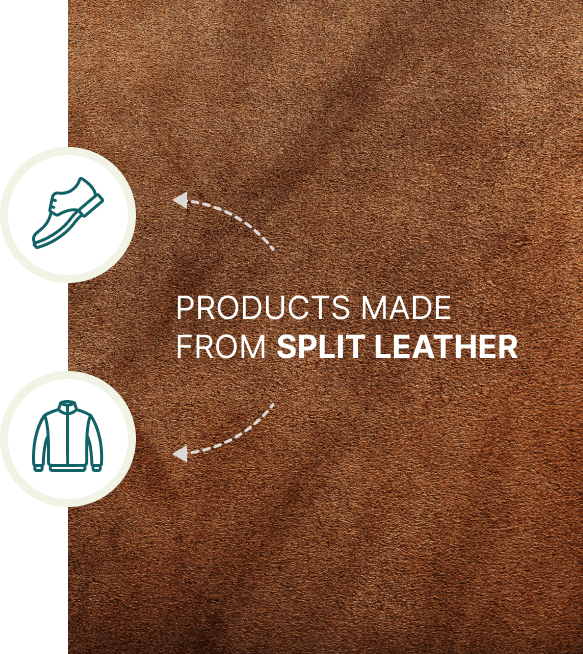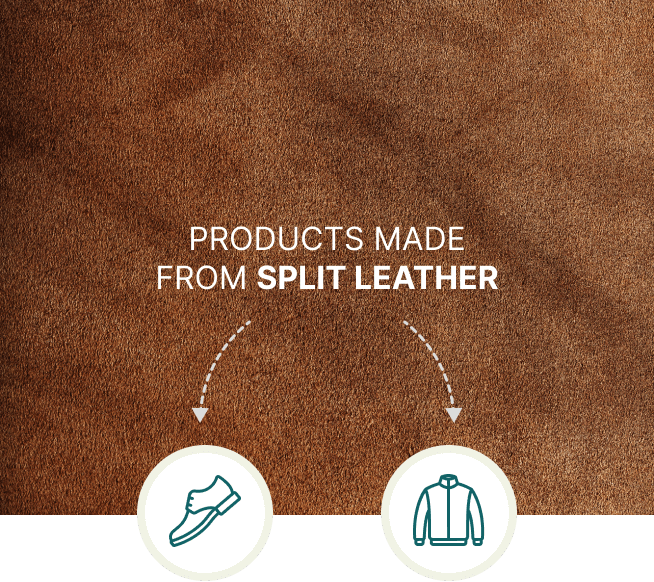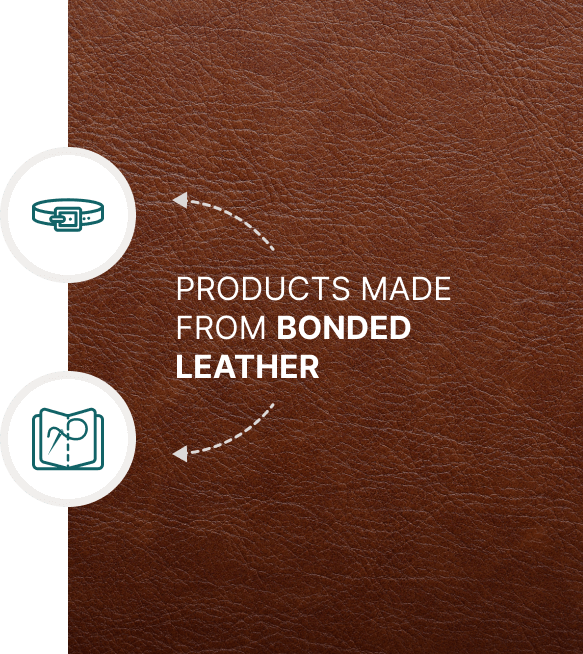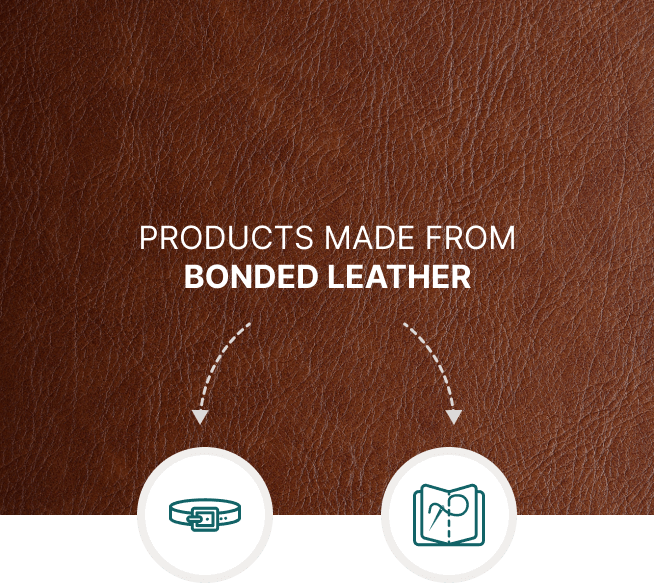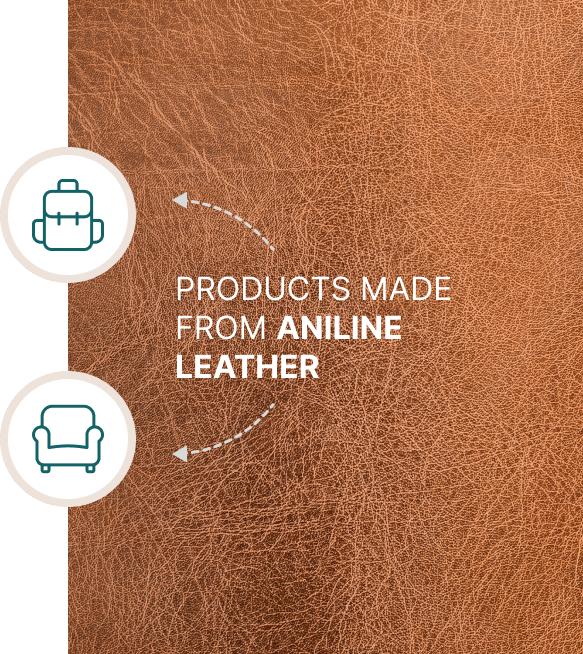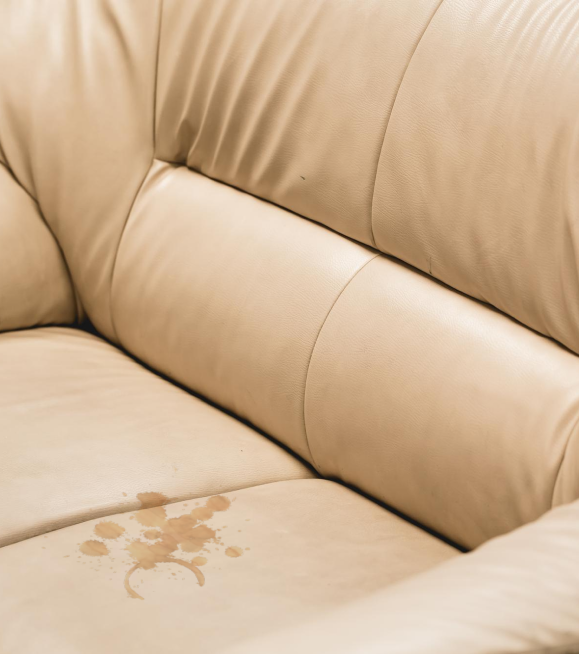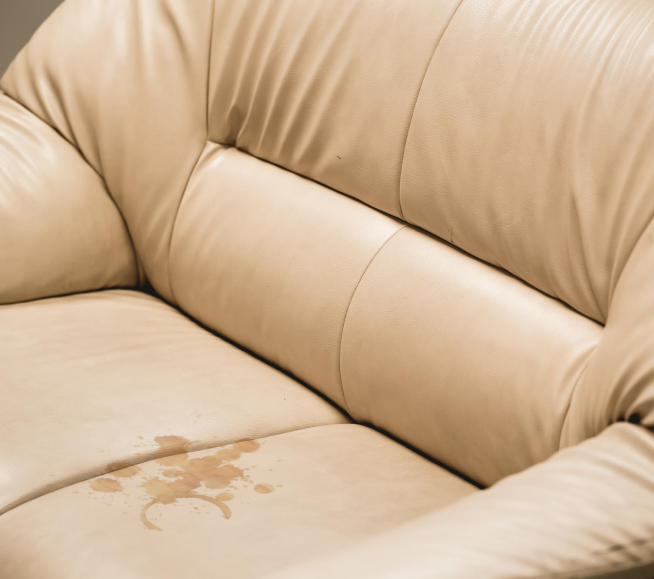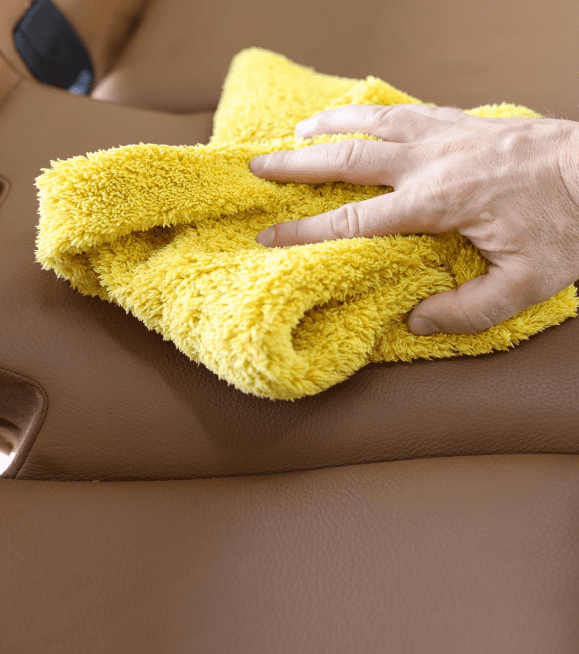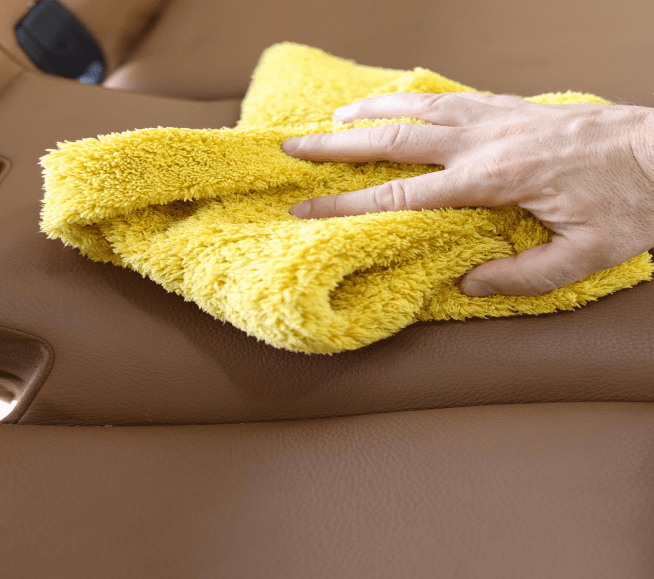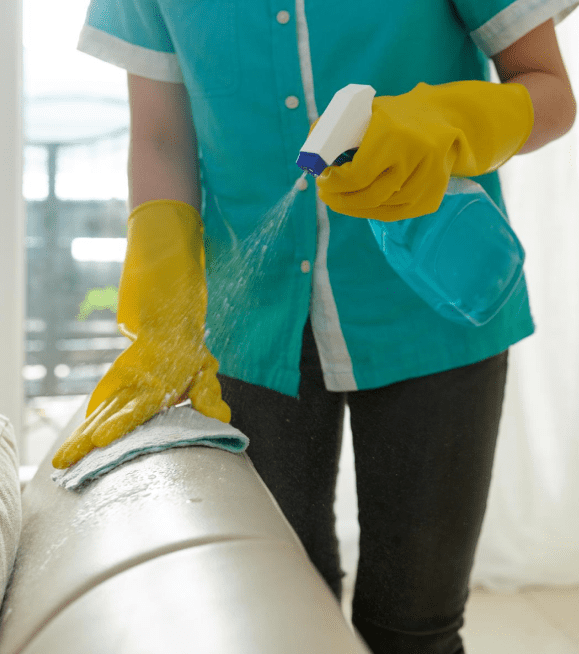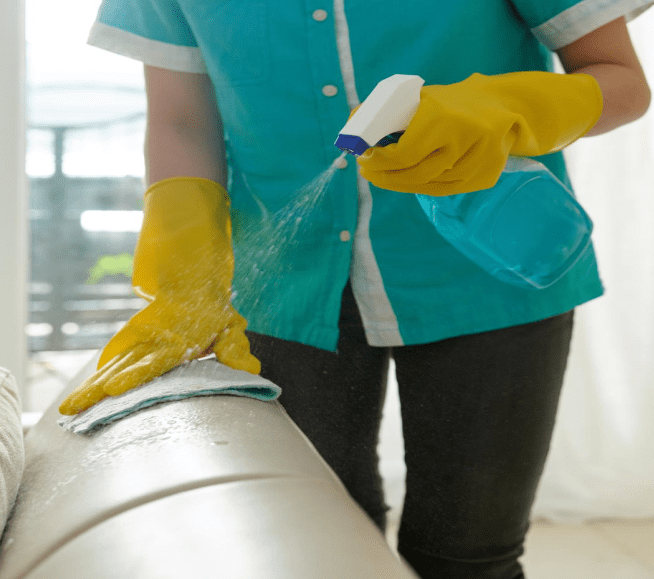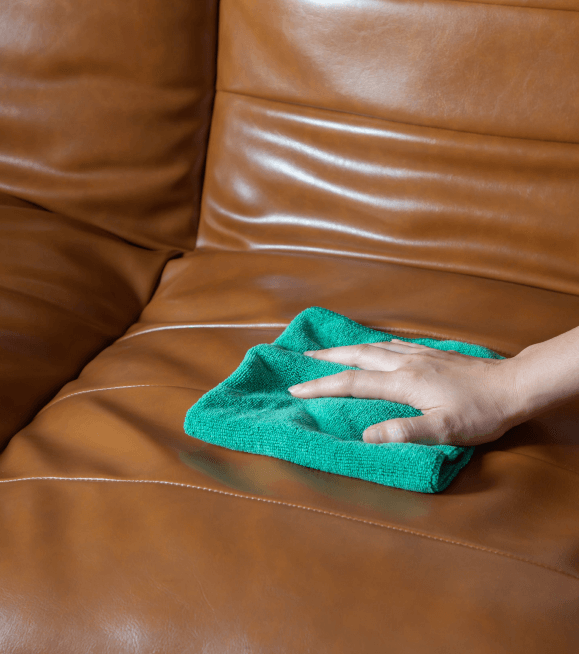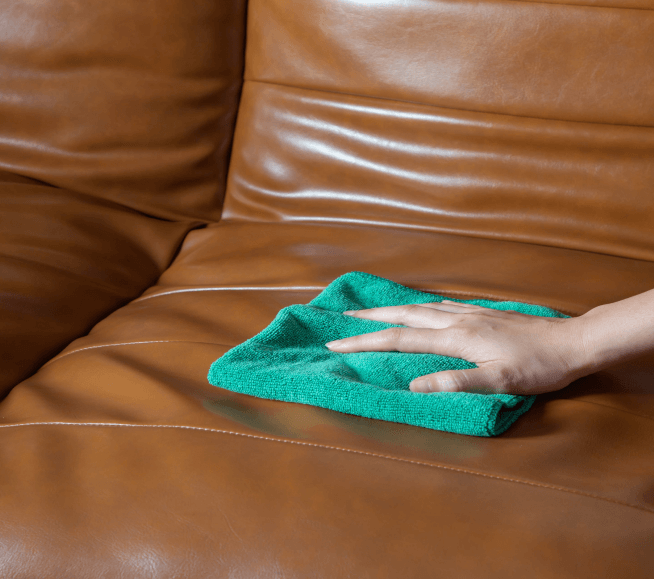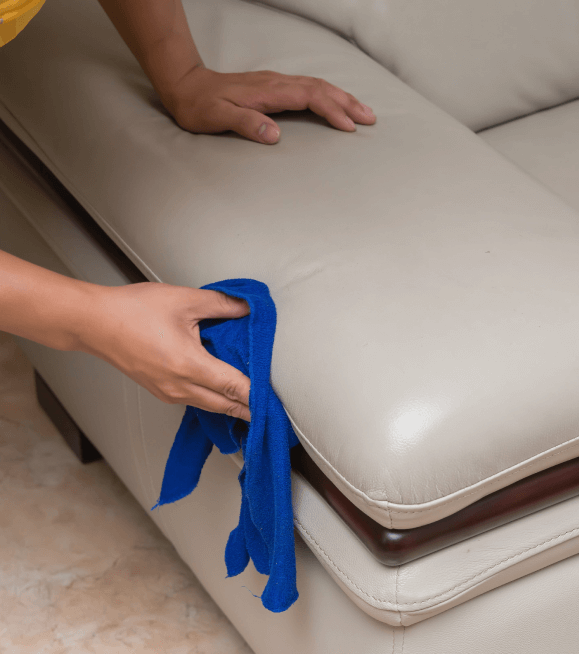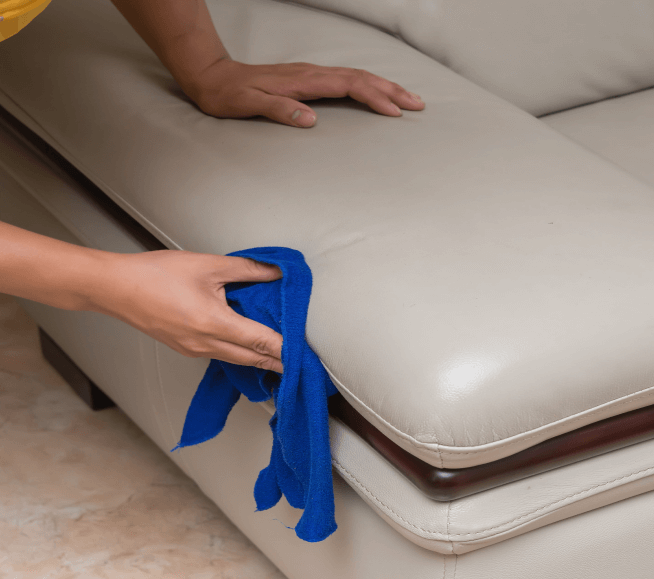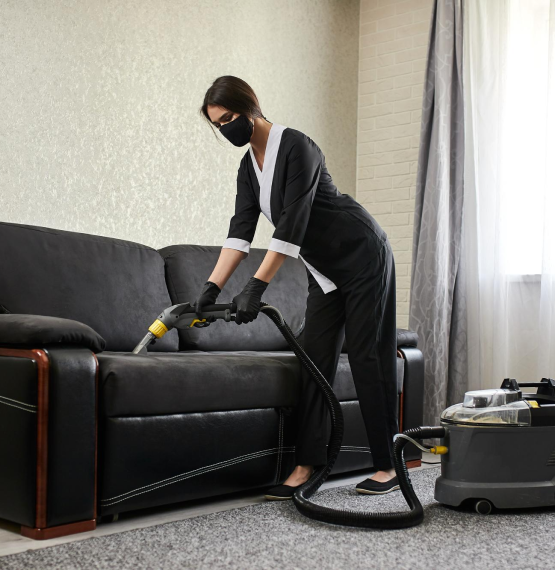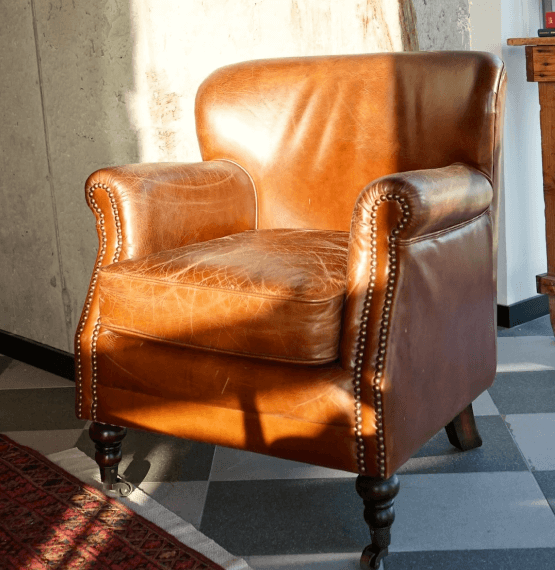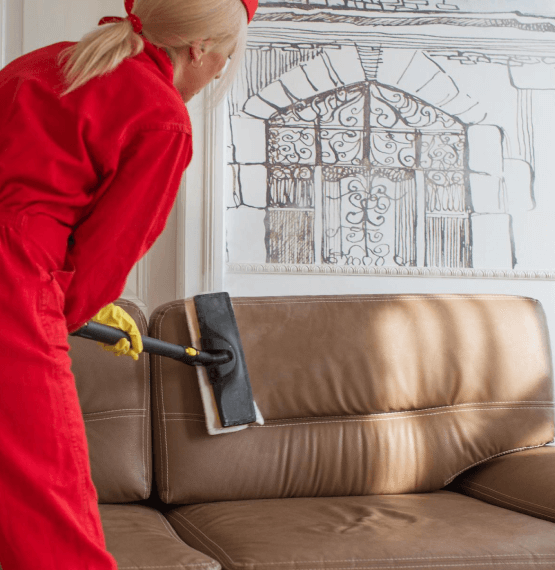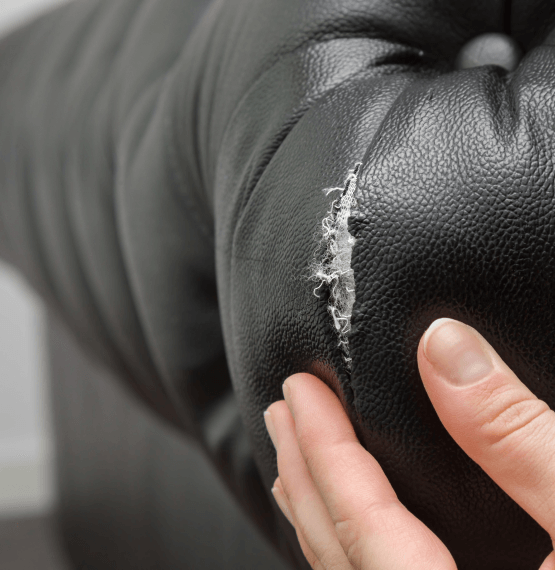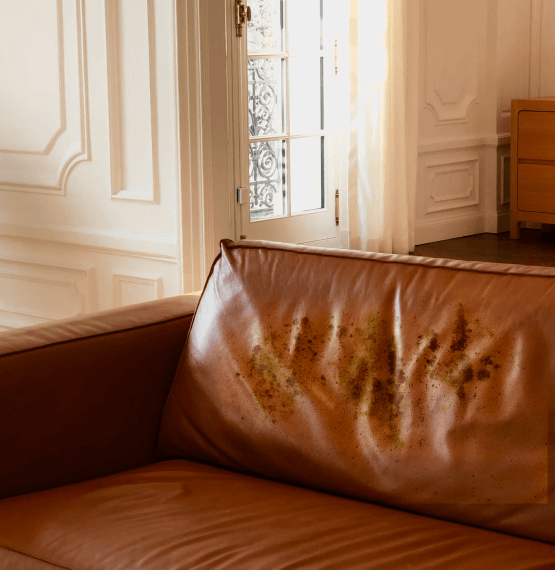How to Clean
a Leather Couch

With well-preserved pieces lasting between 15 and 20 years.
A good leather couch is a statement piece guaranteed to elevate any living or chic commercial space. For many, longevity and durability are two unique selling points that leather couch investors consider, with well-preserved pieces lasting between 15 and 20 years.
Of course, like many worthwhile items, a genuine leather couch relies on routine cleaning to remove dirt, splashes, and spoilage to preserve color and functionality.
In this blog post, we’ll outline how to clean a leather couch to keep it looking fresh and delve into various tools you’ll need to develop good cleaning practices.
5 Types of Leather
Surprisingly, there’s no ‘one-size-fits-all’ cleaning solution to keep your leather looking its best.
Identifying the type of leather your furniture uses is the best way to clean a leather couch. So how do you do this?
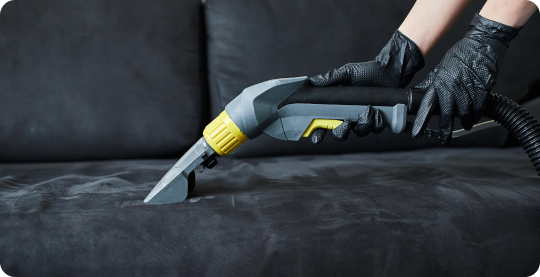
Read on to find out more about different leather types and what to look for during an examination:
How to Tell What Type of Leather My Couch is Made From
As you’ll now recognize, each leather type possesses different structures, durability, and surfaces, emphasizing the need for varying care methods.
The following guide provides five core steps you should take to identify what materials your sofa uses and determine the best way to clean a leather couch:
Five core steps to identify sofa materials and clean a leather couch.
Check For Labels
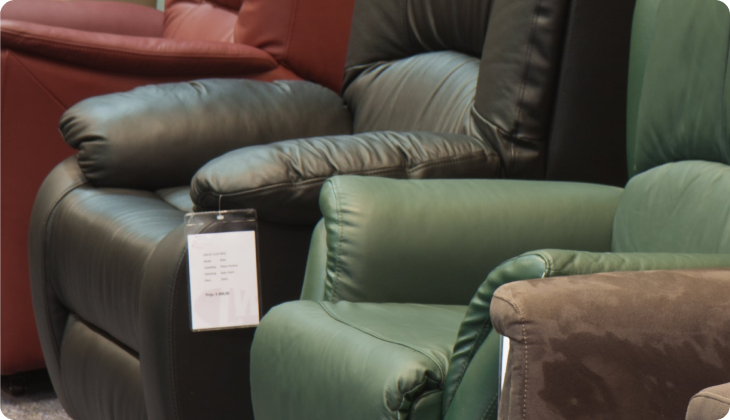
Manufacturers typically attach a statement of authenticity to genuine leather products, so searching for this is a positive first step.
They may have tied the label to the underside of the couch’s cushions, underneath the whole item, or at the back by a bottom corner. Look for labels that say “aniline,” semi-aniline,” “pigmented,” or “nubuck.”
Sometimes, the label gets removed due to wear and tear and second-hand purchasing. In that case, look at your purchase details for specifications. If you’re an organized individual, you’re bound to keep every detail of your purchases. Review your paper receipt, digital invoice, or care documents with your leather couch to find the material name.
Examine the Texture
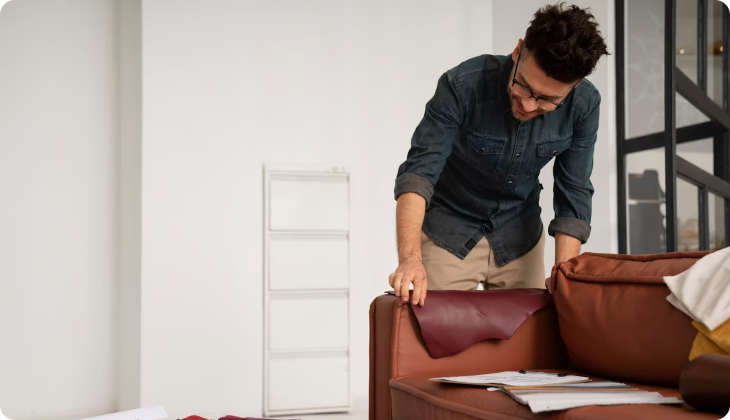
While all leathers have slightly different textures, genuine and fake leather have the most significant difference in a tough test.
First, glide over the surface of the leather couch’s top or cushions, feeling for any bumps or unusual roughness.
Next, push against the leather. Fake leather is typically unnatural and rigid to the touch, so it decompresses when there’s pressure. Genuine leather has some stretch and flexibility, so it will only sink in the area where you’re pushing.

For example, genuine split leather has a fuzzy, soft feel, as it’s likened to suede, but the several-layer structure gives it some movement. Meanwhile, top-grain and full-grain are natural to touch, and nubuck has a velvety feel.
Observe the Color
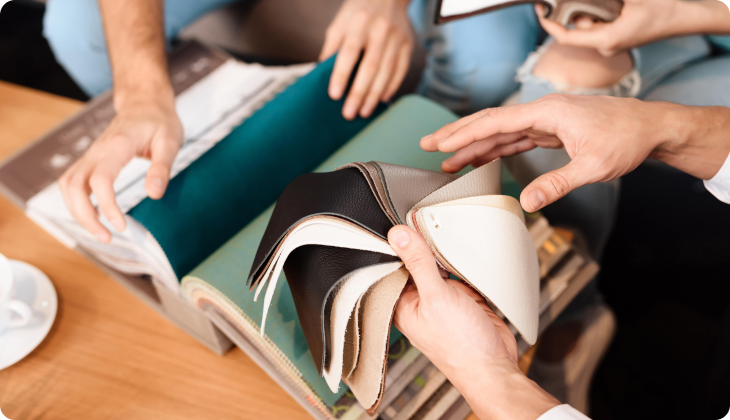
Authentically preserved leathers, like full-grain and aniline, are easy to distinguish, as the natural marks from the animal when it was alive remain visible.
Sanded top-grain leathers, like nubuck, typically take a light color. They face the risk of discoloration, particularly when situated in direct sunlight, such as by windows or in conservatories.
If your couch has a pigmented protective layer, look for the embossing to see whether it has genuine grains.
Perform a Water Drop Test
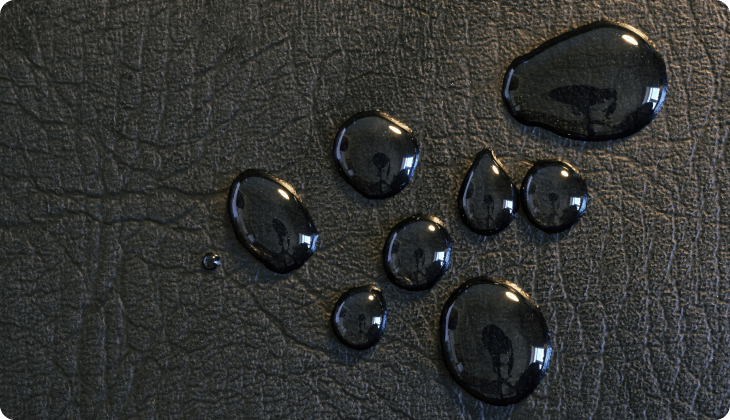
A water drop test is a simple, home-crafted way to identify the type of leather your couch uses is genuine. Use a pipet or a small utensil, like a teaspoon or the tip of a closed pen, and let water droplets fall onto the couch’s surface. Try prioritizing hidden areas, like the under fold beneath cushions’ surfaces, as these relatively untouched areas display the leather in its most natural form.
Keep an eye out for results like this:
- Full- and top-grain with protective layer: Water droplets will bead and sit or roll on top of the surface. Considerable water will bring out the natural oils and possibly darken the patch.
- Aniline leather: Water will soak into the leather easily.
- Semi-aniline leather: Water will first sit on top of the leather’s outer layer, then eventually soak into the material.
Disclaimer: Only use tiny amounts of water during this test, as considerable water can affect the leather’s appearance.
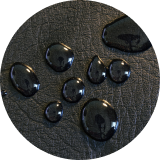
Full- and top-grain with protective layer
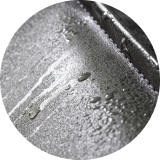
Aniline leather
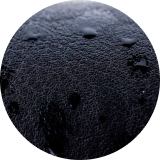
Semi-aniline leather
Consult a Professional

If you reach step five, it’s definitely time to call in the professionals. Discover these leather experts online or in your local community. They may offer furniture maintenance or manufacturing. Alternatively, contact the shop where you bought the couch to see if they have further insight. While you’re there, you could enquire how to clean a leather couch at home.
How Often to Clean a Leather Couch
Environmental factors like proximity to direct sunlight and regularity of use impact how often you should apply leather cleaner. Besides those considerations, determining whether your couch has a protective layer could influence the time you spend cleaning your leather seating.
Here are three quick and easy steps to help you decide how often you need to use leather couch cleaner:
01
Clean your leather couch at least twice a year, as a general rule.
As a minimum benchmark, this cleaning should prevent excessive dirt and debris from building up and preserve the color for longer.
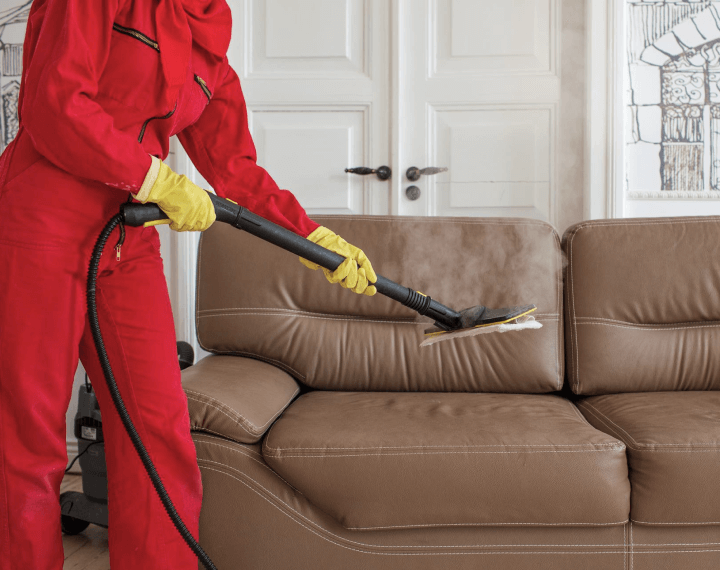
02
Ramp up your cleaning routine if your couch is popular amongst residents and visitors.
Similarly, if you’ve placed your sofa in highly dusty and humid rooms, give it some additional TLC.
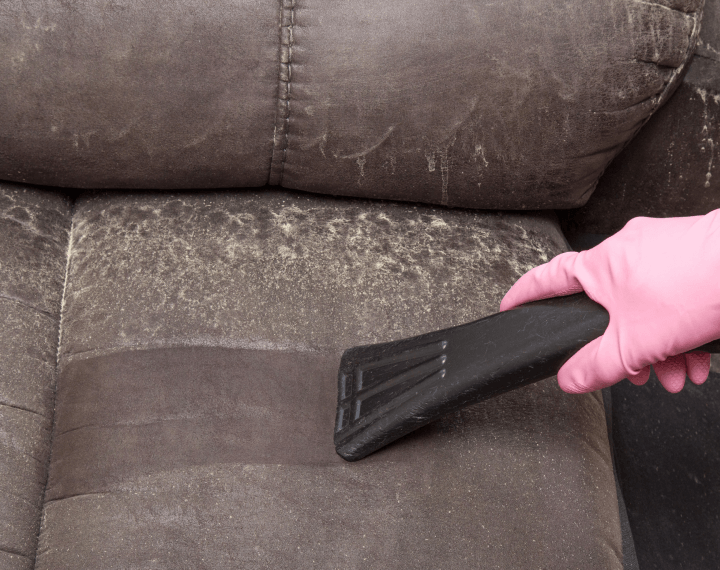
03
Keep an eye out for spills and stains, so you can tackle them immediately, hopefully mitigating or reducing visible effects.
Try not to let liquids or staining products sit on the leather too long, as you’ll minimize your chances of removing it at all.
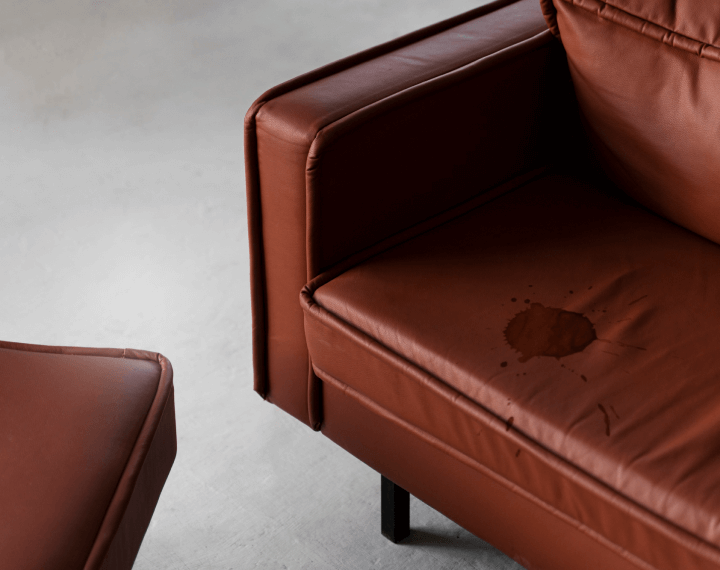
Things You'll Need
When Cleaning Your Couch
Equip your cleaning cupboards with specific leather cleaner and conditioner and gentle cleansing tools. Here’s a helpful checklist you could use that answers what to clean a leather couch with:
Here’s a helpful checklist for leather couch cleaning
Soft-bristled Brush
Soft bristle brushes like toothbrushes or paint brushes are excellent at removing dirt and dust from the corner crevices of your leather couch. They glide over the leather gently, significantly reducing the risk of scratches and scrapes. Avoid harsh bristles from brooms or dustpan and brush sets.
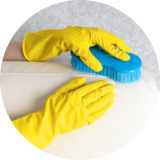
Soft-bristled Brush
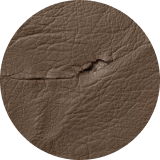
Gentle brush minimizes scratches.
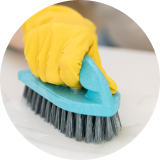
Avoid harsh bristles brush
Leather Cleaner or Leather Safe Household Products
Buy specialized cleaner for your leather couch to ensure you don’t use hazardous or abrasive solutions that damage or weaken your key furniture pieces. Unlike harsh cleaning products, leather cleaner successfully removes dirt, excess oils, and grime without affecting the couch’s natural or protective layer.
As an alternative to dedicated leather cleaner, leather-safe products include leather milk, honey, and protectant sprays. Regardless of what you’re using, always read the instructions provided to guarantee it’s safe to use on your valuable leather couch.
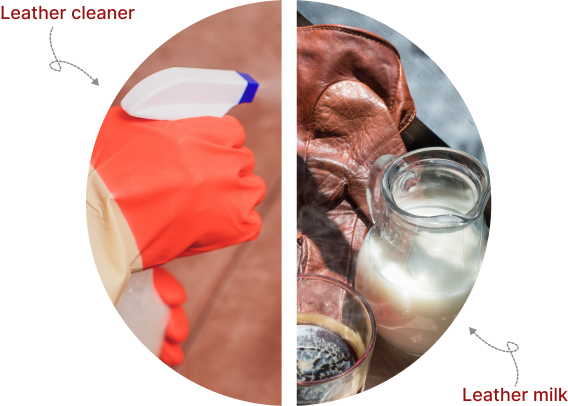
Continue reading for further insight on what you can and can’t use on leather couches!
Microfiber Cloths
As a leather couch owner, microfiber cloths will become one of your trusted tools.
Microfiber cloths are soft and smooth to touch and excellent at gathering and wiping dust.
They’re also absorbent, meaning you can use them to apply appropriate liquids to gather unseen grime effectively.
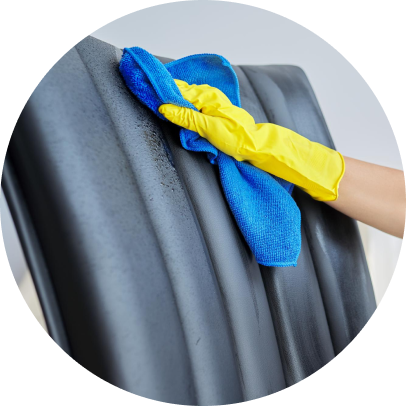
Leather Conditioner
Once you’ve completed a full clean, apply a leather conditioner to moisturize and protect the leather.
Just like our skin, leather typically has a good amount of stretch, but after a while, it can lose some elasticity, increasing the risk of cracking and wrinkling.
Leather conditioner hydrates the leather, leaving it fresh and rejuvenating some color.

Distilled Water
Distilled water dilutes the leather cleaner and conditioner without the risk of contaminating the solution with hard minerals or impurities commonly found in tap water.
Although you can buy distilled water singularly, you can also purchase water distillers to complete the process at home. As healthy leather couches last over a decade, this might be an investment you consider.
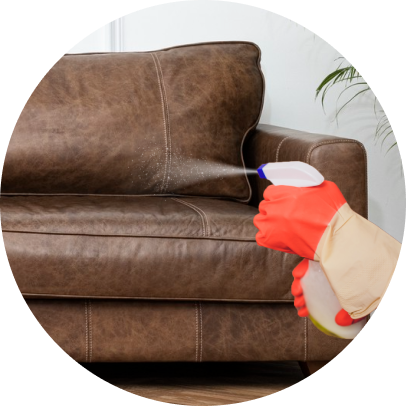
Vacuum Cleaners
With Soft-Bristled Attachments
Getting the vacuum to clean your couch can eliminate hidden dust and debris, like crumbs and hair, from beneath the sofa’s cushions and around the rims. It would be best to use soft bristle attachments to prevent the hard corners of plastic add-ons or the metal pole from snagging or scratching your leather.
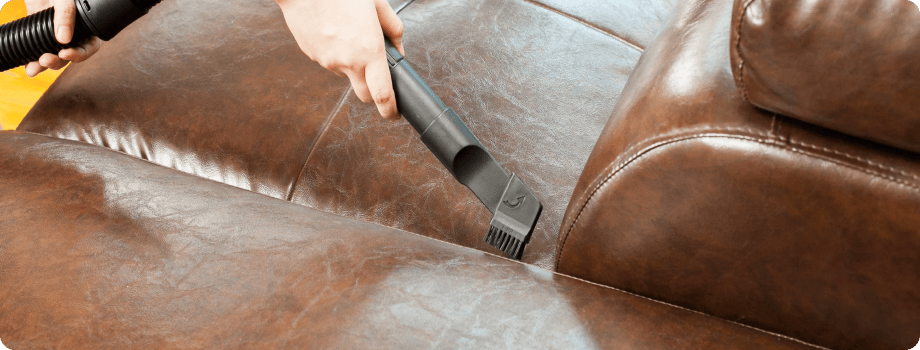
How to Clean a Leather Sofa
Now you’ve followed the guidance above and made a list of items to replenish your leather couch cleaning stock; it’s time to get cleaning. Here’s a detailed step guide describing how to clean a leather couch correctly:
STEP 1: CONDUCT A PRELIMINARY CLEAN
Before using any water or liquids to clean your sofa, you must remove all items and debris to tackle a clean base. It also prevents the risks of pushing dust and grime further into the leather’s structure. Remove any loose dirt or dust from the sofa’s corners, surrounding areas, and surfaces with a soft-bristled brush or a vacuum cleaner with a soft-bristled attachment.
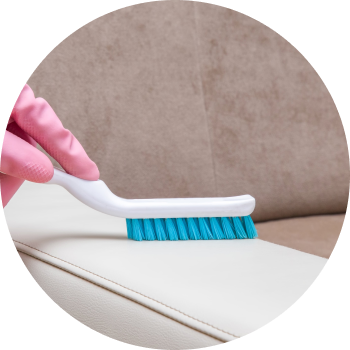
Step 2: Test the Solution on Your Couch
First, use the manufacturer’s instructions to mix the leather cleaner with diluted water. Perform a small patch test on a less visible area of the couch to ensure the cleaner is safe to use on the sofa’s entirety.
Step 3: Start the Leather Couch Clean
Once you’ve approved your cleaning solution, you can start with your deep cleaning. Use microfiber cloths to wipe down the back and bottom cushions and along the couch arms if they, too, are made from leather.
Work section-by-section so you don’t over-saturate the whole couch with the cleaning solution, as this runs risks of the solution drying on the couch. As you’ll learn in the following step, you want to avoid this.
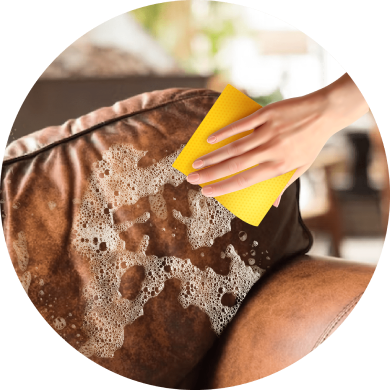
Step 4: Wipe Away the
Cleaning Solution
Once you’ve wiped all leather sections, use a clean but damp microfiber cloth to remove any solution left on the surface. Inspect each area you cleaned so any excess solution doesn’t sit on the leather while drying. Leaving the cleaner on the sofa might dull the shine once you’ve completed the wash or cause staining.
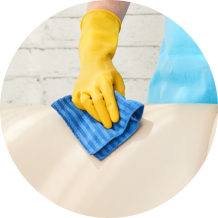
Use microfiber cloth to remove any solution
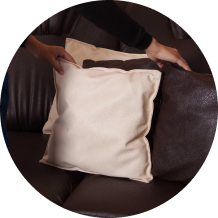
Inspect each area you cleaned
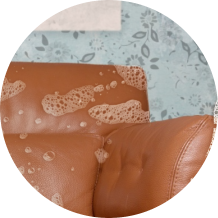
Avoid leaving the cleaner on the sofa.
Step 5: Allow for Drying
Let the sofa air dry naturally to preserve the appearance and stretchiness of the leather.
Although speeding the process may be tempting, avoid using hair dryers or moving the couch into direct sunlight, as forced, heated drying methods can cause cracking.
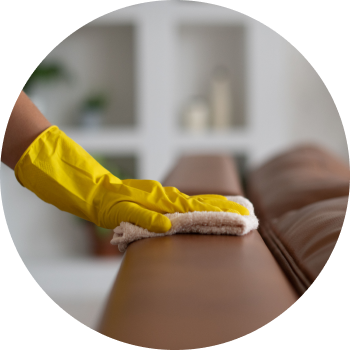
Step 6: Apply Leather Couch Conditioner
Touch different areas of the couch to ensure it’s completely dry. Once you have the all-clear, you can go in with your specialized leather conditioner to keep the material soft and supple. You won’t skip this step if you want to keep your couch looking fresher for longer.
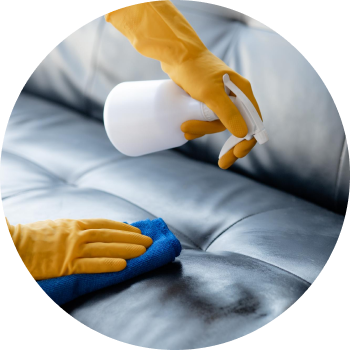
Step 7: Buff the Couch
Buff the leather sofa with a clean, dry microfiber cloth to remove any excess conditioner and restore its natural shine. This is the final step of the cleaning process and helps maximize all the above points and leaves you with a clean sofa.
Use another clean, this time dry, microfiber cloth to remove leftover conditioner, bringing our the couch’s natural shine. Use gentle, circular motions to work excess conditioner into the leather, taking off any extra product. Finally, review the end result and enjoy your refreshed couch!
How to Spot-Clean a Leather Couch
We’re all guilty of slight drink or condiment spillages while relaxing on our leather couches. Spot cleaning saves you the time and effort of cleaning your whole couch after this mistake and, instead, targets the stained area only.
Consider following the steps below to spot-clean your leather couch:
Maintaining your Leather Couch
Leather couches are timeless pieces, no matter the area they occupy. Their sleek, often natural color fits nicely into any decorative style. A well-maintained leather couch is worth four fabric couches, so putting effort into maintenance and cleanliness really does generate great results, making that investment worthwhile.
Check out these valuable tips on maintaining your leather couch!
1 / 7
Dust regularly
Removing dust every week slows the buildup of dirt.
Tending to your couch weekly also helps you notice spills and stains that went under the radar, meaning you can remove them promptly.
2 / 7
Create a conditioning routine
While we understand the benefits of leather conditioning, knowing how to maintain hydration is vital to longevity.
Use leather conditioner every six to twelve months, even between total cleans (although it’s better to work with an all-around fresh surface).
3 / 7
Keep out of sunlight
When possible, keep leather couches away from direct sunlight by placing them away from window bays.
If your home won’t allow it or doesn’t align with your interior visions, consider hanging blinds and curtains to cover couches during peak hours of sunlight. Alternatively, use throws and seat covers to prevent direct exposure when you aren’t using the sofa.
4 / 7
Steer clear of heat sources
Significant heat from sources like radiators and fireplaces and dry your couch out, so try positioning it away from these areas.
Also, avoid leaning hot mugs on the sofa arms to prevent rings from forming.
5 / 7
Check leather cleaning product ingredients
Read ingredient lists carefully, and avoid products containing alcohol, bleach, or ammonia, as these can damage the leather.
6 / 7
Use leather protectant
Leather protectant creates a barrier between leather surfaces and exterior damages like stains and spillages.
Use protectant spray or cream every six to twelve months a year.
7 / 7
Rotate the cushions
If you sit on the same side of your couch regularly, swap your main cushions around, so they remain even in appearance and quality.
The Do’s and Don’ts of Cleaning Leather
Although leather couch cleaning may seem a breeze, learning the do’s and don’ts will help you curate a cleansing routine that works for you and your unique couch. Keep reading for a closer look:
Leather cleaner
Find a pH-neutral cleaner free from harsh or abrasive chemicals. Please read the package’s specifications before using it, or speak with the retailer or manufacturer for solution recommendations. Leather cleaner kills harmful bacteria and microorganisms, breaking down grease and excess oils.
Mild soap and water
If you can’t get hold of leather cleaner or run out and spill something, use very mild soap and distilled water. Use a microfiber cloth as usual and use gentle wiping strokes. Don’t leave excess water sitting on the surface’s top for too long to prevent water damage. Use a dry cloth to remove moisture once clean and leave it to air dry.
Vinegar
Homemade cleaning hacks involve white vinegar and distilled water. White vinegar contains beneficial acids that break down dirt and grime and kill harmful bacteria. Use the same wiping and drying methods as previously discussed.
Commercial Leather Wipes
Pre-moistened commercial leather wipes offer a convenient cleaning solution that explicitly targets the cleanliness of leather couches. Dispose of these correctly and don’t flush them down the toilet.
Bleach or ammonia
Bleach and ammonia can negatively affect the coloration of leather, making it appear unnaturally light. Leather cleaners have bacteria-killing qualities, so use this instead.
Harsh chemicals
Abrasive or strong chemicals like alcohol and acetone can dry out your leather couch, increasing cracking or tearing.
Furniture polish
Furniture polish may contain harmful substances like silicone that leave residue on leather, which, over time and depending on your leather type, could sink in and cause strange staining.
Tap water
Tap water can contain various impurities and minerals like chalk or natural oils that bind with the protective layer of your leather couch. As a result, discoloration or staining could appear.
Sponges or scourers
Ridged, wired, or rough-edged sponges can scuff and scratch your leather couch. It can also damage the natural shine and protective layers beyond repair.
When to Call Professionals
If you’re looking at your leather couch and are feeling intimidated by the stain you see, there’s a high likelihood that calling a professional offers the best solution.
Call on professional help in the following scenarios:
Conclusion
The bottom line is leather couch cleaning totally depends on the type of leather you own, the products you own, and your confidence in overseeing such a task.
For example, if you have a top-grain leather couch and notice mold growing at a specific point, it’s best to consult a professional cleaning service to protect your costly investment and prolong its life.

If you have a bonded leather couch with a small soft, bristled vacuum and microfiber cloth is sure to do the trick. Approach each cleaning session gently and with patience.

Investing in a leather couch may seem daunting, but there are many ways to maintain its quality. With regular cleaning to remove debris and dirt and spot cleaning, as soon as you notice any stains or marks, you stand a better chance of having an all-around high-quality and well-maintained sofa. The durable leather will look good as new.
What supplies will I need to clean my leather couch?
To clean a leather couch, you’ll require a soft cloth, warm water, a mild detergent or leather cleaner, and a leather conditioner. You may choose to use liquid wax and wear rubber gloves to protect yourself. Before applying any cleaning product to the entire couch, make sure to test it on an inconspicuous area first. To keep your leather couch looking great, be sure to wipe it gently with a damp cloth. Avoid any rough rubbing as this could damage the surface. Apply conditioner and allow it to dry completely. This will help to restore and maintain the vibrant colors of your couch for years to come.
How often should I clean my leather couch?
To keep your leather couch in good condition, it’s advised to clean it every six to twelve months, depending on its usage and traffic. Along with this, it’s recommended to do spot cleaning as necessary for better upkeep of its appearance. To maintain the longevity of your leather couch and if you have pets or children who use it often, it is recommended to clean it more frequently. Thankfully, with proper care, your leather couch can last for many years without requiring much effort from your end.
How do I clean my leather couch if it's starting to look dull?
Regularly applying leather conditioner to your leather furniture will prevent it from becoming dull. This will help maintain the fresh and vibrant look of your leather couch for many years. To bring back the shine of a leather couch using a conditioner, follow these steps: start by vacuuming the couch to get rid of dirt and crumbs. Next, use a soft cloth to apply a small amount of leather conditioner on the surface. Make sure to spread the conditioner evenly over the entire area. Gently rub the material using circular motions to apply the product. Allow it to sit for up to 24 hours and then use another clean cloth to wipe away any remaining residue.
How do I remove a stain from my leather couch?
If you want to get rid of a stain on your leather couch, follow these precautions. First, identify the type of stain and check if it’s water-based or oil-based. In the case of water-based stains such as coffee and wine, dampen a clean cloth with lukewarm water and gently dab at the stain until it disappears. In case of oil-based stains, such as grease or makeup, use a leather cleaning solution. Use a soft cloth to apply the product evenly, then gently rub it to loosen the stain. Afterward, wipe away any residue using a separate clean cloth. If the stain remains, repeat these steps until it is completely removed.
What is the best way to protect my leather couch from future stains?
Regularly treating your leather couch with a leather conditioner is the most effective way to safeguard it against future stains and maintain its vibrancy. Leather conditioner replenishes the natural oils in the leather, which helps in keeping your furniture looking fresh. You can also can use a protective spray on your furniture. This spray forms an invisible barrier that helps to repel dirt and makes cleaning up spills or everyday grime easier. It is recommended to reapply the protective spray every few months for optimal results.
How do I clean the leather couch if my pet has been on it?
If your pet has been on your leather couch, you can clean it by following these steps: Start by removing any fur or dust with a soft cloth or vacuum. Afterward, mix a mild detergent or leather cleaning solution in lukewarm water and use it to clean the couch. To clean your couch, dampen a cloth with the solution and gently clean the fabric. For the leather couch, apply the solution gently in circular motions and use a dry cloth to remove any remaining residue. Do not use excessive cleaner or scrub too hard as it may damage your furniture. Once cleaned, allow the treated area to dry before using it again.
What should I do if my leather couch starts to crack?
To prevent further damage, prompt action is necessary if your leather couch starts to crack. Check the manufacturer’s instructions for guidance on treating cracked leather couches. In the absence of any recommendations, consider using a leather furniture conditioner. To reduce cracking and boost moisture content in the fabric of your couch, options like moisturizer or oil such as coconut or almond oil can come in handy. Gently apply the oil into the cracks using your fingers or a soft cloth. Wipe off any excess oil with a clean cloth. Wait for 24 hours for the couch to fully absorb the oil before sitting on it again. To prevent future dryness and damage, use a moisturizer or oil regularly.
Can I use a vacuum on my leather couch?
It’s safe to use a vacuum on your leather couch as long as you use a setting suitable for leather and be gentle while vacuuming. You should use a soft brush attachment that is more suitable for furniture fabrics rather than a regular hard-bristled broom head. It’s important to avoid using too much suction force as it may cause permanent marks or tears in the leather surface. To avoid harsh cleaners or chemicals causing scratches and discoloration of your couch fabric, it’s best to first vacuum away dust and dirt particles before using a damp cloth or other cleaning product.
What are some general tips for cleaning a leather couch?
Here are some general tips to keep in mind when cleaning your leather couch:
1. Before using a cleaning product on your couch, test it on an inconspicuous area.
2. To remove dust and dirt, use a soft cloth or vacuum with an appropriate attachment.
3. Be gentle when vacuuming and avoid using too much suction force to prevent fabric tears.
4. Clean your leather sofa in small sections to avoid streaks and spotty patches over time.
5. To keep your leather furniture looking fresh for years, make sure to use a high-quality leather conditioner regularly. This will help nourish the material and protect it from wear and tear.
6. If you need to remove stains, apply a gentle cleaner using circular motions. Be careful not to damage or discolor the upholstery fabric, and wipe away any excess cleaner with a dry cloth. If possible, check the manufacturer’s instructions for any specific treatment recommendations based on the type of material used.
How do I clean the cushions on my leather couch?
Here are the rewritten instructions for cleaning leather couch cushions to increase clarity:
1. Use an appropriate vacuum attachment to remove dust and debris from the cushions.
2. Mix a mild detergent or leather cleaning solution with lukewarm water.
3. Dampen a soft cloth in the cleaning solution and gently wipe the cushion cover.
4. Be careful not to scrub too hard as it may harm the fabric.
5. Dry off any remaining moisture with another soft cloth.
Repeat these steps until the cushion is adequately cleaned and free of dirt and grime. Allow it to air-dry before you sit on it again. You can also use leather conditioner after cleaning for extra protection against future wear and tear.


